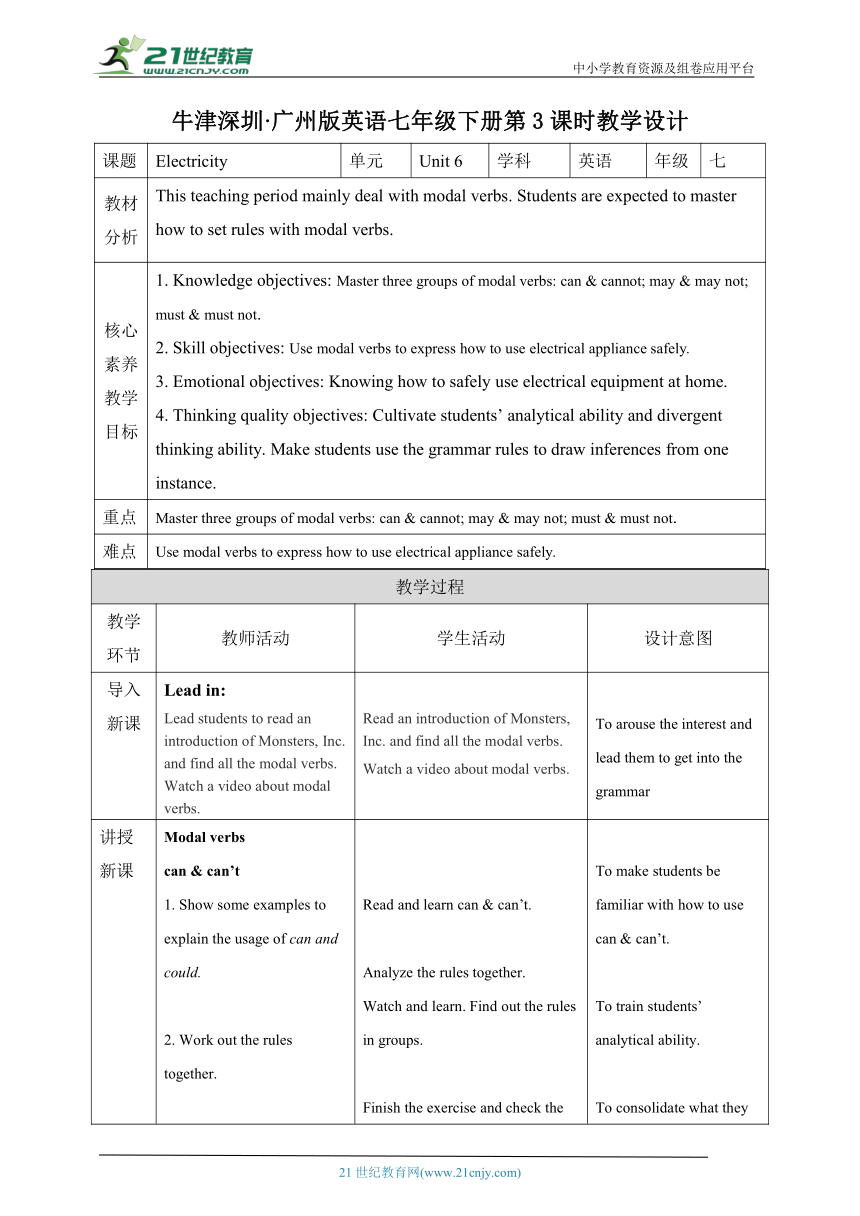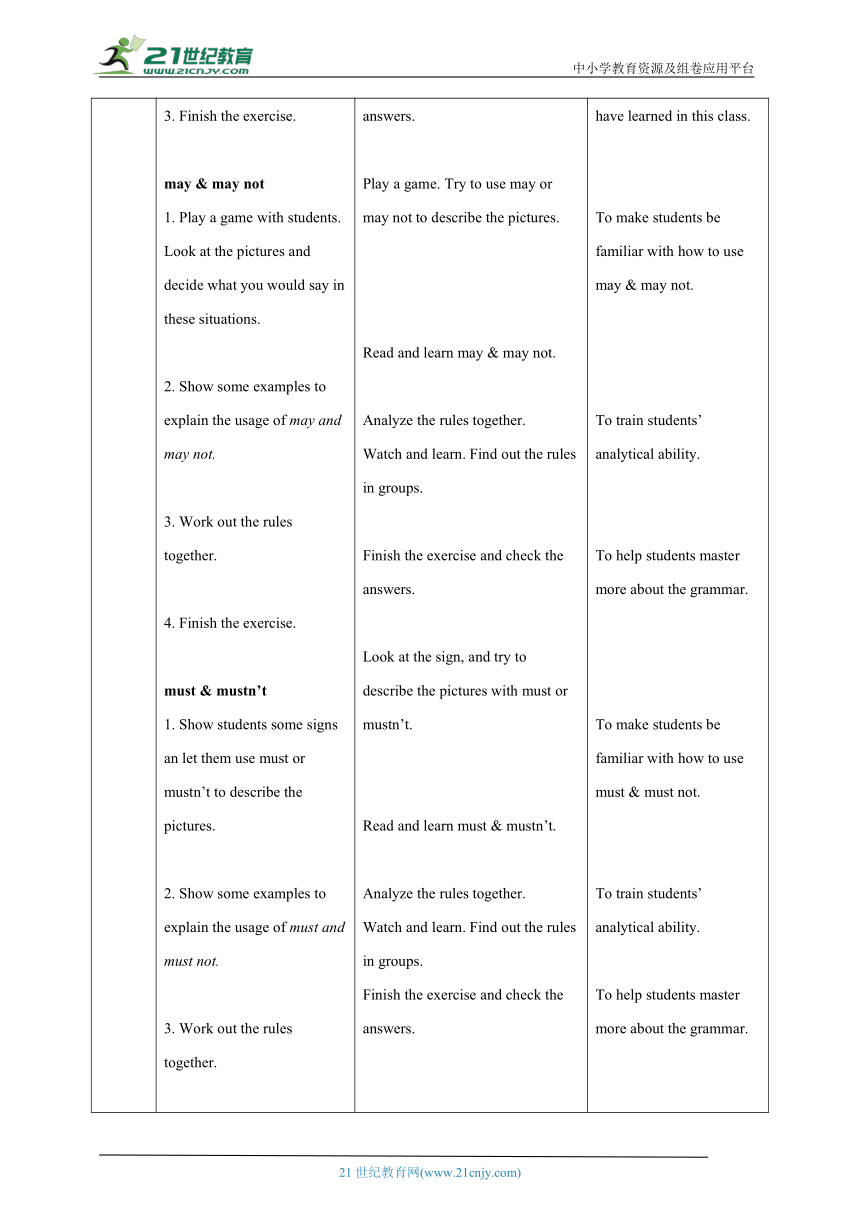【核心素养目标】Unit 6 Electricity 第3课时Grammar教案
文档属性
| 名称 | 【核心素养目标】Unit 6 Electricity 第3课时Grammar教案 |  | |
| 格式 | doc | ||
| 文件大小 | 1.2MB | ||
| 资源类型 | 试卷 | ||
| 版本资源 | 牛津深圳版 | ||
| 科目 | 英语 | ||
| 更新时间 | 2023-04-26 09:58:24 | ||
图片预览


文档简介
中小学教育资源及组卷应用平台
牛津深圳·广州版英语七年级下册第3课时教学设计
课题 Electricity 单元 Unit 6 学科 英语 年级 七
教材分析 This teaching period mainly deal with modal verbs. Students are expected to master how to set rules with modal verbs.
核心素养教学目标 1. Knowledge objectives: Master three groups of modal verbs: can & cannot; may & may not; must & must not. 2. Skill objectives: Use modal verbs to express how to use electrical appliance safely.3. Emotional objectives: Knowing how to safely use electrical equipment at home.4. Thinking quality objectives: Cultivate students’ analytical ability and divergent thinking ability. Make students use the grammar rules to draw inferences from one instance.
重点 Master three groups of modal verbs: can & cannot; may & may not; must & must not.
难点 Use modal verbs to express how to use electrical appliance safely.
教学过程
教学环节 教师活动 学生活动 设计意图
导入新课 Lead in:Lead students to read an introduction of Monsters, Inc. and find all the modal verbs.Watch a video about modal verbs. Read an introduction of Monsters, Inc. and find all the modal verbs.Watch a video about modal verbs. To arouse the interest and lead them to get into the grammar
讲授新课 Modal verbscan & can’t1. Show some examples to explain the usage of can and could.2. Work out the rules together.3. Finish the exercise.may & may not1. Play a game with students. Look at the pictures and decide what you would say in these situations.2. Show some examples to explain the usage of may and may not.3. Work out the rules together.4. Finish the exercise.must & mustn’t1. Show students some signs an let them use must or mustn’t to describe the pictures.2. Show some examples to explain the usage of must and must not.3. Work out the rules together.4. Finish the exercise.SummarySummarize the usage of modal verbs.Present the task, and limit the time for students to finish the exercise. Read and learn can & can’t.Analyze the rules together. Watch and learn. Find out the rules in groups. Finish the exercise and check the answers.Play a game. Try to use may or may not to describe the pictures.Read and learn may & may not.Analyze the rules together. Watch and learn. Find out the rules in groups. Finish the exercise and check the answers.Look at the sign, and try to describe the pictures with must or mustn’t.Read and learn must & mustn’t.Analyze the rules together. Watch and learn. Find out the rules in groups. Finish the exercise and check the answers.Review what have been learnt. Take notes.Finish the exercise individually. Check the answers with each other and then discuss the mistakes. To make students be familiar with how to use can & can’t.To train students’ analytical ability.To consolidate what they have learned in this class.To make students be familiar with how to use may & may not.To train students’ analytical ability.To help students master more about the grammar.To make students be familiar with how to use must & must not.To train students’ analytical ability.To help students master more about the grammar.To consolidate what they have learned in this class.To consolidate what they have learned in this class.
课堂小结 本课我们分别介绍了情态动词can 和cannot, may和may not, must和must not的相关用法。鼓励学生运用must和must not来制定规定。
板书 情态动词情态动词具有一定的词义,但不能独立存在,须与动词原形一起构成谓语,表示说话人对动作的观点,如意愿、需要、可能或怀疑等。情态动词有时态的变化,但大多数没有人称和数的变化。【情态动词can的用法】can 可表示能力,意为“能;会”,相当于 be able to;也可表示许可或请求对方允许,意为“可以”。须注意:could 是 can 的过去式,但表示请求许可时,could 和 can不表示时态的区别,只是 could 的语气更加委婉,用 could 提出的请求要用 can 来回答。can 的否定式为 cannot / can’t,意为“不能;不会”或“不可以”,还可表示“可能不”。can 构成的一般疑问句及其回答形式如下:— Can you ... — (肯定回答) Yes, I can.— (否定回答) No, I cannot / can’t.如:Mary can ride a bike, but she cannot drive a car.Can I borrow your eraser Could you show me how to use the mobile phone 【情态动词may的用法】may 表示许可或请求对方允许,意为“可以”,相当于can。两者的区别在于:表示请求许可时,may 更能表示礼貌或敬意。may 的否定式为 may not,意为“不可以”。may 构成的一般疑问句及其回答形式如下:— May I ... — (肯定回答) Yes, you may / can.— (否定回答) No, you may not / can’t /mustn’t. (注:mustn’t的语气最强,表示禁止。)如:You may / can go home now.— May I have lunch now, Mum — No, you may not. You should wash your hands first.【情态动词must的用法】must 表示规定、命令、强制,意为“必须;一定”。 must 的否定式为 must not / mustn’t,意为“禁止;不准”。must构成的一般疑问句及其回答形式如下:— Must I ... — (肯定回答) Yes, you must.— (否定回答) No, you needn’t如:You must go home before 10 p.m.You mustn’t speak too loud here.— Must I clean the floor now — No, you needn’t.【辨析】意义用法must“必须;一定”强调主观上必须做某事have to“不得不;必须”强调客观上不得不做某事
21世纪教育网 www.21cnjy.com 精品试卷·第 2 页 (共 2 页)
HYPERLINK "http://www.21cnjy.com/" 21世纪教育网(www.21cnjy.com)
牛津深圳·广州版英语七年级下册第3课时教学设计
课题 Electricity 单元 Unit 6 学科 英语 年级 七
教材分析 This teaching period mainly deal with modal verbs. Students are expected to master how to set rules with modal verbs.
核心素养教学目标 1. Knowledge objectives: Master three groups of modal verbs: can & cannot; may & may not; must & must not. 2. Skill objectives: Use modal verbs to express how to use electrical appliance safely.3. Emotional objectives: Knowing how to safely use electrical equipment at home.4. Thinking quality objectives: Cultivate students’ analytical ability and divergent thinking ability. Make students use the grammar rules to draw inferences from one instance.
重点 Master three groups of modal verbs: can & cannot; may & may not; must & must not.
难点 Use modal verbs to express how to use electrical appliance safely.
教学过程
教学环节 教师活动 学生活动 设计意图
导入新课 Lead in:Lead students to read an introduction of Monsters, Inc. and find all the modal verbs.Watch a video about modal verbs. Read an introduction of Monsters, Inc. and find all the modal verbs.Watch a video about modal verbs. To arouse the interest and lead them to get into the grammar
讲授新课 Modal verbscan & can’t1. Show some examples to explain the usage of can and could.2. Work out the rules together.3. Finish the exercise.may & may not1. Play a game with students. Look at the pictures and decide what you would say in these situations.2. Show some examples to explain the usage of may and may not.3. Work out the rules together.4. Finish the exercise.must & mustn’t1. Show students some signs an let them use must or mustn’t to describe the pictures.2. Show some examples to explain the usage of must and must not.3. Work out the rules together.4. Finish the exercise.SummarySummarize the usage of modal verbs.Present the task, and limit the time for students to finish the exercise. Read and learn can & can’t.Analyze the rules together. Watch and learn. Find out the rules in groups. Finish the exercise and check the answers.Play a game. Try to use may or may not to describe the pictures.Read and learn may & may not.Analyze the rules together. Watch and learn. Find out the rules in groups. Finish the exercise and check the answers.Look at the sign, and try to describe the pictures with must or mustn’t.Read and learn must & mustn’t.Analyze the rules together. Watch and learn. Find out the rules in groups. Finish the exercise and check the answers.Review what have been learnt. Take notes.Finish the exercise individually. Check the answers with each other and then discuss the mistakes. To make students be familiar with how to use can & can’t.To train students’ analytical ability.To consolidate what they have learned in this class.To make students be familiar with how to use may & may not.To train students’ analytical ability.To help students master more about the grammar.To make students be familiar with how to use must & must not.To train students’ analytical ability.To help students master more about the grammar.To consolidate what they have learned in this class.To consolidate what they have learned in this class.
课堂小结 本课我们分别介绍了情态动词can 和cannot, may和may not, must和must not的相关用法。鼓励学生运用must和must not来制定规定。
板书 情态动词情态动词具有一定的词义,但不能独立存在,须与动词原形一起构成谓语,表示说话人对动作的观点,如意愿、需要、可能或怀疑等。情态动词有时态的变化,但大多数没有人称和数的变化。【情态动词can的用法】can 可表示能力,意为“能;会”,相当于 be able to;也可表示许可或请求对方允许,意为“可以”。须注意:could 是 can 的过去式,但表示请求许可时,could 和 can不表示时态的区别,只是 could 的语气更加委婉,用 could 提出的请求要用 can 来回答。can 的否定式为 cannot / can’t,意为“不能;不会”或“不可以”,还可表示“可能不”。can 构成的一般疑问句及其回答形式如下:— Can you ... — (肯定回答) Yes, I can.— (否定回答) No, I cannot / can’t.如:Mary can ride a bike, but she cannot drive a car.Can I borrow your eraser Could you show me how to use the mobile phone 【情态动词may的用法】may 表示许可或请求对方允许,意为“可以”,相当于can。两者的区别在于:表示请求许可时,may 更能表示礼貌或敬意。may 的否定式为 may not,意为“不可以”。may 构成的一般疑问句及其回答形式如下:— May I ... — (肯定回答) Yes, you may / can.— (否定回答) No, you may not / can’t /mustn’t. (注:mustn’t的语气最强,表示禁止。)如:You may / can go home now.— May I have lunch now, Mum — No, you may not. You should wash your hands first.【情态动词must的用法】must 表示规定、命令、强制,意为“必须;一定”。 must 的否定式为 must not / mustn’t,意为“禁止;不准”。must构成的一般疑问句及其回答形式如下:— Must I ... — (肯定回答) Yes, you must.— (否定回答) No, you needn’t如:You must go home before 10 p.m.You mustn’t speak too loud here.— Must I clean the floor now — No, you needn’t.【辨析】意义用法must“必须;一定”强调主观上必须做某事have to“不得不;必须”强调客观上不得不做某事
21世纪教育网 www.21cnjy.com 精品试卷·第 2 页 (共 2 页)
HYPERLINK "http://www.21cnjy.com/" 21世纪教育网(www.21cnjy.com)
